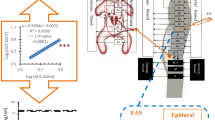Abstract
A physiological model was used to examine the disposition of morphine in the pregnant rat. In the model was incorporated an expression of both a linear and a nonlinear binding term of morphine to the maternal muscular tissue. Furthermore, the experimental data suggested that a diffusion-limited transport of morphine occurred across the placenta. Morphine showed a relatively high partition into the maternal kidney and muscle tissues. The concentration of morphine in the foetus was about 1.5 times higher than that of the maternal plasma, whereas the foetal brain concentration was about 4 times higher than that of the maternal plasma. The influence on morphine disposition by changes in both the tissue binding of the maternal muscle and the placental plasma flow was explored by model simulations. Due to the diffusionlimited transport of morphine across the placenta, a change in the placental plasma flow would only have an effect on the concentration-time profile of morphine in the foetal tissues if the plasma flow approached and became less than the diffusion clearance across the placenta. An increase in the partition of morphine into the maternal muscle produced an increase in the terminal half-life in all tissues including the foetus.
Similar content being viewed by others
References
J. H. Sanner and L. A. Woods. Comparative distribution of tritium-labelled dihydromorphine between maternal and fetal rats.J. Pharmacol. Exp. Ther. 148:176–184 (1965).
G. F. Blane and H. E. Dobbs. Distribution of tritium-labelled etorphine (M99) and dihydromorphine in pregnant rats at term.Br. J. Pharmacol. Chemother. 30:166–172 (1967).
S. Y. Yen and L. A. Woods. Dihydromorphine in the tolerant and non-tolerant rat.J. Pharmacol. Exp. Ther. 174:9–12 (1970).
J. G. Wagner.Fundamentals of Clinical Pharmacokinetics, Drug Intelligence Publications, Hamilton, Ill., 1975, pp. 92–96.
P. O. Edlund. Determination of opiates in biological samples by glass-capillary gas chromatography with electron capture detection.J. Chromatogr. 206:109–116 (1981).
K. B. Bischoff, R. L. Dedrick, D. S. Zaharko, and J. A. Longstreth. Methotrexate pharmacokinetics.J. Pharm. Sci. 60:1128–1133 (1971).
C. M. Metzler, G. L. Elfring, and A. J. McEwen.NONLIN. The Upjohn Co., Kalamazoo, Mich., 1974.
B. Dahlström, J. Jonsson, and L. Paalzow. Morphine metabolism in the perfused rat liver.Acta Pharmacol. Toxicol. 39:46–52 (1976).
K. J. Himmelstein and R. J. Lutz. A review of the application of physiologically based pharmacokinetic modelling.J. Pharmacokin. Biopharm. 7:127–145 (1979).
B. Dahlström and L. Paalzow. Pharmacokinetics of morphine in plasma and discrete areas of the brain.J. Pharmacokin. Biopharm. 3:293–302 (1975).
B. Dahlström and L. Paalzow. First-pass metabolism of morphine and its pharmacokinetic interpretation.J. Pharmacokin. Biopharm. 6:521–527 (1978).
B. Dahlström, P. Bolme, H. Feychting, G. Noack, and L. Paalzow. Pharmacokinetics of morphine in children.Clin. Pharmacol. Ther. 26:354–365 (1979).
B. Fichtl and H. Kurz. Binding of drugs to human muscle.Eur. J. Clin. Pharmacol. 14:335–340 (1978).
C. N. Chen and J. D. Andrade. Pharmacokinetic model for simultaneous determination of drug levels in organs and tissues.J. Pharm. Sci. 65:717–724 (1976).
M. L. Kirby. Morphine in fetuses after maternal injection: increasing concentration with advancing gestational age.Proc. Soc. Exp. Biol. Med. 162:287–290 (1979).
C. A. Guyton.Textbook Of Medical Physiology, 5 ed. W. B. Saunders, Philadelphia, 1975, p. 251.
H. J. Kupferberg and E. L. Way. Pharmacological basis for the increased sensitivity of the newborn rat to morphine,J. Pharmacol. Exp. Ther. 141:105–112 (1963).
P. T. Henderson. Metabolism of drugs in rat liver during the perinatal period.Biochem. Pharmacol. 20:1225–1232 (1971).
B. A. Berkowitz. The relationship of pharmacokinetics to pharmacological activity; morphine, methadone and naloxone.Clin. Pharmacokin. 1:219–230 (1976),
M. Gibaldi and J. R. Koup. Pharmacokinetic concepts-drug binding, apparent volume of distribution and clearance.Eur. J. Clin. Pharmacol. 20:299–305 (1981).
B. L. Mirkin.Perinatal Pharmacology and Therapeutics. Academic Press, London, 1976, pp. 15–25.
M. A. Heymann. Interrelation of fetal circulation and the placental transfer of drugs.Fed. Proc. 31:44–47 (1972).
L. Jansky and J. S. Hart. Cardiac output and organ bloodflow in warm- and cold-acclimated rats exposed to cold.Can. J. Physiol. Pharmacol. 46:653–659 (1968).
Y. Lundgren, K. Karlsson, and U. Ljungblad. Circulatory changes during pregnancy in spontaneously and renal hypertensive rats.Clin. Sci. 57:337–339 (1979).
S. F. Brunk and M. Delle. Morphine metabolism in man.Clin. Pharmacol. Ther. 16:51–57 (1974).
G. R. Wilkinson and D. G. Shand. A physiological approach to hepatic drug clearance.Clin. Pharmacol. Ther. 18:377–390 (1975).
Author information
Authors and Affiliations
Rights and permissions
About this article
Cite this article
Gabrielsson, J.L., Paalzow, L.K. A physiological pharmacokinetic model for morphine disposition in the pregnant rat. Journal of Pharmacokinetics and Biopharmaceutics 11, 147–163 (1983). https://doi.org/10.1007/BF01061846
Received:
Revised:
Published:
Issue Date:
DOI: https://doi.org/10.1007/BF01061846




